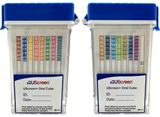CANNABIS TESTING IS BECOMING MORE COMMON IN DRUGGED DRIVING INVESTIGATIONS
In recent years, drugs that act on the brain have increasingly been recognized as a significant hazard to road traffic and public safety. Research indicates that marijuana is the most common illegal drug detected in impaired drivers, fatally injured drivers, and motor vehicle crash victims.
Effects of marijuana on driving
According to research studies by the National Council on Alcoholism and Drug Dependence (NCADD), driving under the influence of drugs poses threats to public safety that are similar to alcohol because drugs have a negative effect on the driver’s judgment, reaction time, motor skills, and memory. When misused, prescription drugs, over-the-counter drugs, and illegal drugs can impair perception, judgment, motor skills, and memory.

Marijuana significantly impairs judgment, motor coordination, and reaction time, and studies have found a direct relationship between blood THC concentration and impaired driving ability.
Driving while impaired is illegal
While some states have legalized marijuana use, federal law considers a person guilty of a DUI if they drive under the influence of a controlled substance and such substance impairs their facilities. If a death or serious injury results, then a chemical drug test will be mandatory. An officer may use reasonable force, if necessary, to obtain a blood sample if the driver refuses.
Mixing drugs and driving, regardless of whether it's marijuana or legally prescribed muscle relaxers, is just as illegal as driving drunk and can also constitute a DUI offense.
How is Cannabis testing conducted?
Investigators are trained to detect drug impairment the same as they detect alcohol. They observe how a driver behaves both behind the wheel and once pulled over, detecting a telltale smell or conducting field-sobriety testing. Once in the suspect is custody on suspicion of driving under the influence, drivers is asked to take part in testing. For alcohol, troopers use a breath test. For drugs, they take a blood or urine sample.
In a urine drug test, a donor provides a urine sample in a cup. A drug testing collection specialist will then seal the specimen cup, complete various types of documentation including a chain of custody form. They will make sure the donor initials the specimen cup seal, provides identification, and upon completion of the collection and paperwork, the specimen is sent to the laboratory for testing by courier.
Drug testing that utilizes the method of drawing blood is not common, but is still in use by many governmental agencies and the court systems. Blood drug testing measures whether a person has an illegal drug metabolite in their system at the time the blood is drawn.
American Drug Testing can provide DOT and non-DOT drug testing. Our testing centers offer 5,7,9,12, and 14-panel drug screenings analyzed by a SAMHSA Certified laboratory. A license Medical review officer verifies a licensed Medical review officer verifies all test results. The detection period for drug use is 1 to 5 days, however with chronic marijuana use it can be up to 30 days. We have many types or rapid tests that detect marijuana use. Our single panel and multi-panel cup tests are FDA 510(k) Approved, CLIA Waived and marked for OTC (Over the Counter) use without a prescription.
Recent Posts
-
Why Adulterant Panels Matter: Enhancing Integrity in Drug Test Cups and Dip Cards
Detailed Overview of Urine Adulterants Introduction: The Importance of Adulterant Panels in Drug Tes …Jun 4th 2025 -
UScreen® Oral Plus 16-Panel Saliva Flip-Top Cube: Unmatched Coverage, Accuracy, and Ease of Use
Employers and organizations continue to shift toward oral fluid drug testing for its sp …May 28th 2025 -
Understanding Fentanyl and Norfentanyl Testing: Key Information
Fentanyl and Norfentanyl are closely related compounds associated with opioids. With numerous testin …Apr 29th 2024



